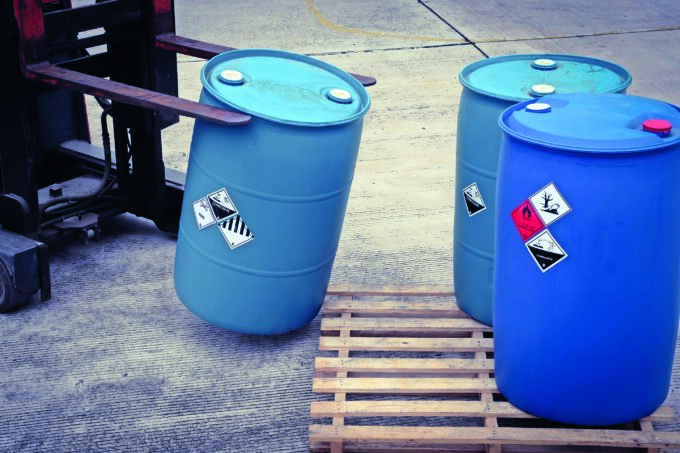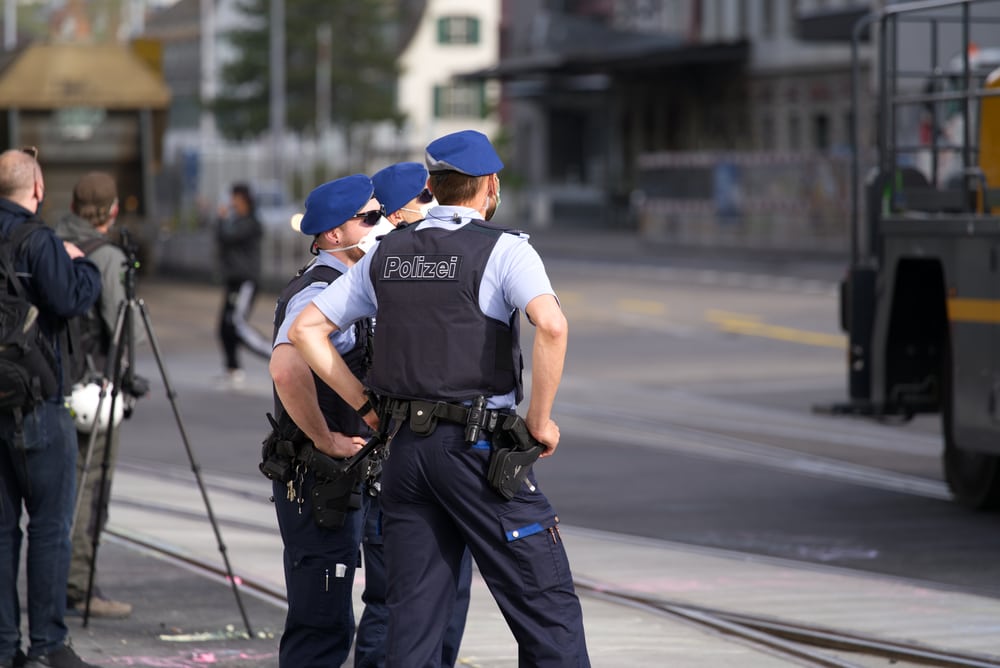Transport of empty, uncleaned dangerous goods packaging
In almost all branches of industry and commerce, products or raw materials are used that are classified as dangerous goods. After using the dangerous goods, the company also wants to get rid of the emptied containers. It should be noted that the transport of the empty, uncleaned containers to a disposal company or back to the supplier falls under the dangerous goods regulations.

The emptied, uncleaned hazardous material containers are not simply to be considered hazard-free. As a rule, a small amount of the hazardous substance is still present in the emptied containers, so that the containers still represent a potential hazard. For example, if a flammable liquid was in a container, there is still an explosive atmosphere inside the container that can be ignited by an ignition source. In the case of a container that has contained a corrosive substance, there is a risk that the loader or unloader may be injured when handling this empty container if splashes of the substance still adhere to the outside or the container is not properly closed.
The dangerous goods regulations therefore define the conditions under which empty, uncleaned dangerous goods containers may be transported. In principle, the ADR (Agreement concerning the International Carriage of Dangerous Goods by Road) states in accordance with 4.1.1.11 that uncleaned empty packagings of dangerous goods are subject to the same regulations "as filled packagings, unless appropriate measures have been taken to eliminate any danger".
The ADR permits a number of different variants for the transport of empty dangerous goods packaging, which are explained in more detail below. In addition, when transporting empty dangerous goods packaging, it must not be forgotten that it is subject to waste legislation when it is disposed of and that, in addition to the transport regulations, there may also be waste-legislation requirements for documentation and labeling.
Variant 1: Shipment as dangerous goods without application of exemptions
The standard variant is to transport empty, uncleaned packages as if they were filled containers. This means that the vehicle has the orange panels unfolded, the driver has an ADR training certificate and all the necessary equipment and a transport document with him. The empty, uncleaned containers must then meet the same conditions as filled containers:
- They must be tight and sealed.
- They must show the hazard labels and the UN number of the last filling material.
- There must be no hazardous residues adhering to the outside.
The described variant 1 is often used when transporting hazardous waste, where the driver takes not only containers filled with hazardous waste, but also empty, uncleaned packaging.
However, the required entries in the transport document are simplified for empty, uncleaned packagings. It is not necessary to indicate the number of empty packagings and to name the dangerous goods precisely. According to ADR 5.4.1.1.6.2.1, the detailed information according to ADR 5.4.1.1. can be omitted and replaced by the summary information "Empty packagings with residues of ...", followed by a listing of the hazard labels (class and subsidiary risk) of the empty packagings carried. Example: Empty packagings with residues of 3, 6.1, 8. This regulation applies to most dangerous goods, except explosives (Class 1), infectious substances (6.2) and radioactive substances (Class 7).
On the other hand, for empty dangerous goods containers with residues of Class 1 and 6.2 goods, all information according to ADR 5.4.1.1.1. is required, except for the total quantity of dangerous goods according to letter f). According to ADR 5.4.1.1.6.1, the description in the transport document must also be supplemented with the expression "Empty, Uncleaned" or "Residues of the last substance contained". This more elaborate type of documentation is also permitted for all empty, uncleaned dangerous goods packagings, with the exception of Class 7.
There is a special facilitation for the return transport of empty containers to the supplier of the dangerous goods. In this case, the consignor can use the transport document of the associated delivery, delete the quantity information and replace it with the expression "Empty, uncleaned return" (see ADR 5.4.1.1.6.2.3).
Variant 2: Facilitated transport with application of the exemption
ADR 1.1.3.6 describes exemptions in connection with the quantities carried per vehicle (transport unit). Colloquially, this exemption is known as the 1000-point rule (each dangerous goods container counts mass points, in total there must not be more than 1000 points on the vehicle).
As long as packagings have not contained dangerous goods of transport category 0 (which is the case for most commercial products), empty uncleaned packagings fall into transport category 4. For goods of transport category 4, the exemption according to ADR 1.1.3.6 may be applied indefinitely. Empty uncleaned packagings therefore do not contribute to the mass points on the vehicle, which means that a vehicle may carry any number of empty uncleaned packagings and at the same time apply the exemption according to ADR 1.1.3.6. When this exemption is applied, the transport is exempt from many requirements of "normal" transport of dangerous goods. For example, it allows the transport vehicle to travel without an orange plate and without the extensive dangerous goods equipment (exception: a 2-kg fire extinguisher) and the driver does not need an ADR training certificate according to ADR 8.2.1.
Normally, ADR 1.1.3.6 requires that a transport document be carried when this exemption is applied. In Switzerland, however, there is another exemption that is only valid nationally: SDR (SR 741.621), Annex 1, subsection 8.1.2.1, letter a): "Empty uncleaned packagings of transport category 4 may be transported without a transport document, with the exception of UN number 3509."
Variant 3: Exclusion of any danger
ADR 1.1.3.5 states that empty, uncleaned packagings are not subject to ADR regulations "if appropriate measures have been taken to eliminate possible hazards. Hazards are excluded when measures have been taken to eliminate the hazards of classes 1 to 9." This regulation is limited in ADR to packagings that have contained Class 2, 3, 4.1, 5.1, 6.1, 8 and 9 dangerous goods. Unfortunately, the ADR does not specify which measures are sufficient to eliminate hazards.
In Germany, this was therefore officially defined in the Implementation Guidelines for Dangerous Goods (RSEB). According to the guidelines, a hazard can be excluded if
- the packaging does not contain hazardous vapors or residues that can be released,
- the packaging is completely emptied or the residual contents are neutralized, bound, cured, polymerized or chemically reacted, and
- if no hazardous residues adhere to the outside of the packaging.
These requirements mean that the exemption according to ADR 1.1.3.5 is difficult to implement in operational practice because the empty containers would have to undergo a cleaning or inactivation process for this. However, this effort is usually not economical just to get used empty containers off the yard.
Variant 4: Transport of empty, uncleaned packaging as dangerous goods
UN number 3509 "Old packagings, empty, uncleaned" was introduced in 2015, in particular to cover the transport of damaged packagings and those with missing closure. Such damaged or old packagings no longer meet the requirements for a functional packaging in accordance with ADR 4.1.1.1.
This packaging, which is no longer functional, may not simply be placed on the loading area for transport or fixed to a pallet with shrink film, but must be packed for transport in the regular manner. Permitted for this purpose are:
- Packagings according to packing instruction P003 using special provision RR9,
- IBC according to packing instruction IBC08 using special instruction BB3,
- Large packages according to packing instruction LP02 with application of special instruction LL1.
These packagings do not have to be design tested according to ADR 4.1.1.3. but they must meet the applicable construction requirements for packagings. In particular, they must be liquid-tight, puncture-resistant and tightly closed. Prior to filling and transfer for carriage, each packaging must be inspected to ensure that it is free from corrosion, contamination or other damage. Packagings showing signs of reduced resistance must no longer be used.
Old packagings that have contained liquid hazardous materials must be packed in rigid packagings equipped with retention means (e.g. absorbent material). Old packaging that has contained solid hazardous materials that cannot liquefy at transport temperature may be packed in flexible packaging (e.g. big bags).
Special provision 663 in particular must be observed when using UN 3509. This provision imposes a number of additional restrictions with regard to the use of UN 3509:
- Containers that are to be reconditioned, repaired, maintained or reused must not be transported as UN 3509. Containers transported under UN 3509 go to disposal or to a material recycling process.
- The containers must be largely empty. Open containers or expired goods must not be transported under UN 3509.
- Permitted to use UN 3509 only for used packaging that previously contained Class 3, 4.1, 5.1, 6.1, 8 or 9 dangerous goods.
- Packagings with residues of substances of packing group I are excluded
- Various other particularly hazardous groups of substances are excluded
- As the tightness of the old packaging is no longer guaranteed, containers with hazard label 5.1 (oxidizing substances) must not be packed together with other old packaging (otherwise there is an acute risk of fire).
- A documented grading procedure must be established at the loading site to ensure compliance.
Conclusion
Different situations at the consignor of empty, uncleaned packages with dangerous goods residues make different measures necessary when organizing the transport. Analyze which dangerous goods residues may occur on site and what condition the containers are in. Carefully study the regulations mentioned in the article that are relevant to you. In case of doubt, seek advice from a professional disposal company or a dangerous goods specialist.
Author: Dr. Stephan Steines, Chemical Safety Consultant, Swiss Safety Center









